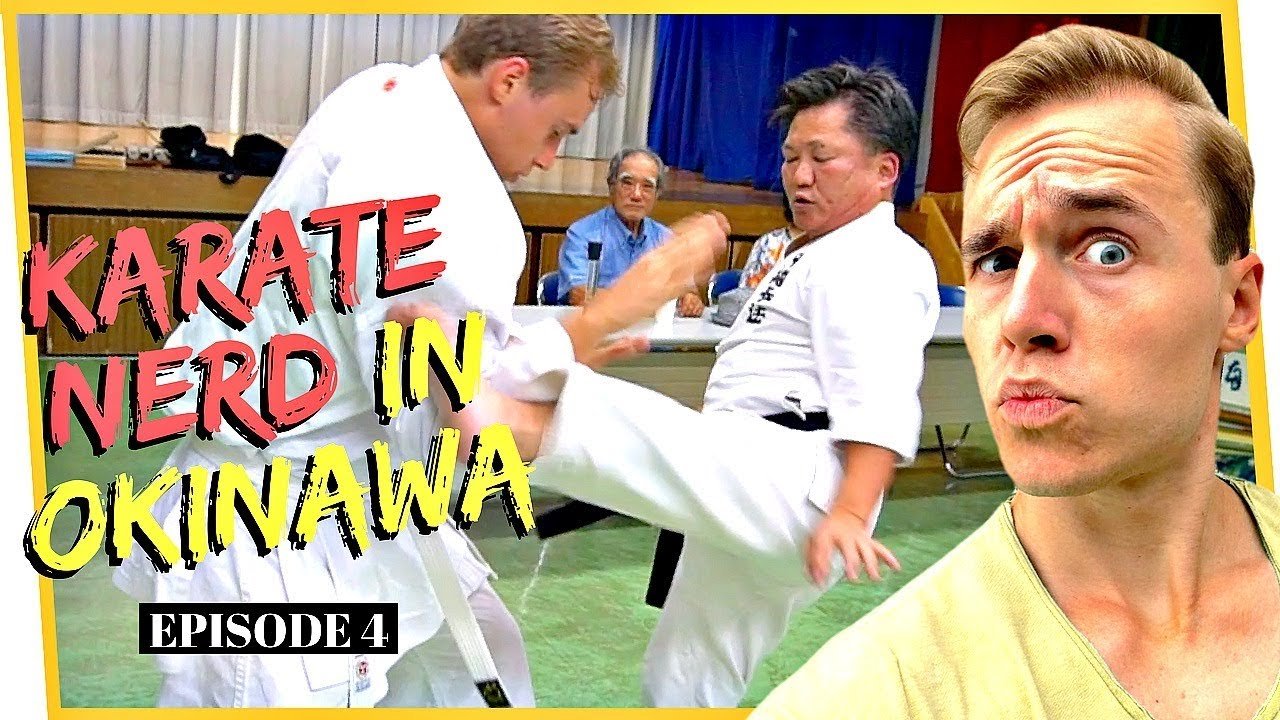Jesse Enkamp’s Practical Karate Applications
In a video dated 2017, renowned karate instructor, Jesse Enkamp, shares an insight into one of his seminars in Munich, Germany. With over 100,000 views, the video delves into the concept of KATA BUNKAI, which is all about practical karate applications.
The Concept of Kojiki
The video begins with Enkamp introducing an exercise he developed himself, named Kojiki, which means “time machine” in Japanese. This exercise is designed to help students understand the meaning of kata and its practical applications, also known as bunkai. The term “bunkai” refers to the breakdown of forms or kata in karate, uncovering their true functionality.
Role Rehearsal in Karate
One of Enkamp’s main points is that learning kata (solo routines) and then trying to apply them in a defensive situation is putting the cart before the horse. He suggests that traditionally, one would first learn a self-defence move and then recreate it solo. This process aids in the memorization, practice, and improvement of that particular sequence of techniques.
Understanding Kata
According to Enkamp, without understanding the purpose of a kata, we are like singers who can sing a song perfectly in a foreign language but do not understand the meaning of the words. Thus, enriching one’s understanding of kata is crucial to practical applications in martial arts.
Practical Application of Kata
In the seminar, Enkamp tries to reverse the traditional learning order. He introduces a variety of self-defence situations and their variations, encouraging participants to develop effective responses. He emphasises that the goal of these exercises is to understand kata in a new light, thereby improving practical karate applications.
One Kata, Three Years
Jesse Enkamp concludes the seminar by referencing an Okinawan saying, “one kata three years”. This saying reflects how it used to take three years of practice to truly understand and apply a single kata. He argues that this approach would ensure a thorough understanding of kata, fostering more effective self-defence techniques.
The video showcases Enkamp’s teaching prowess and contribution to the world of karate, shedding light on a more comprehensive and practical understanding of karate techniques. His passionate approach serves as a reminder that karate is a journey, not just a series of techniques to be memorised. This makes it a must-watch for all karate enthusiasts who wish to deepen their understanding and improve their skill set.
[postx_template id=”84″]
Jesse Enkamp: The Karate Nerd
Jesse Enkamp is a world-renowned karate expert, an author, and an entrepreneur. Known as the “Karate Nerd,” Enkamp has dedicated his life to mastering the art of karate and sharing his extensive knowledge with students all around the globe. He is highly revered for his unique and effective teaching methods, which he disseminates through his popular YouTube channel and his own online training platform. In addition to his karate prowess, he also sets an outstanding example with his dedication to personal growth and continuous learning. Enkamp’s influence goes beyond the dojo, inspiring people in all walks of life.
[postx_template id=”177″]
Practical Application of Karate in MMA and Fighting Sports
Traditionally, Karate is often viewed as a rigid, stance-based martial art. However, its practical applications in the realm of Mixed Martial Arts (MMA) and other fighting sports can’t be underrated. Indeed, the power, speed, and technical skills in karate are instrumental to the discipline of any solid fighter. This is particularly true in striking, where karate’s sharp, precise punches and kicks can deliver significant damage. Karate also emphasizes the necessity of resolute focus and mindset, which is an invaluable trait within the highly competitive sphere of MMA. It’s a testament to karate’s enduring utility within modern combat sports.
[postx_template id=”85″]
Practical Japanese Martial Arts History
Japanese martial arts, also known as “Bujutsu”, date back from the Samurai period of Japan. These techniques were not just for sport but for survival during wars. The martial arts evolved over centuries, reflecting changes in the Japanese warrior culture, eventually leading to the development of “Budo” – modern Japanese martial arts.


 (Omote, Ura, Honto)
(Omote, Ura, Honto) 









Thanks for your AWESOME comments! Check out my website for more Karate stuff: http://www.karatebyjesse.com
Awwwww Jesse that thumbnail tho
Thank you, Jesse. I am getting old and have had massive heart problems. I can still sit in front of a computer and I still have to actually fight on my workdays. I deal with mental health for a living and I have been a practitioner of Karate for almost forty years. Because of Karate no patient who attacked me got hurt… nor did I. Thank you Master Junki Yoshida for teaching my teachers correctly. I will never forget one hundred push-ups because of getting out of control during a match. The punishment was well deserved. I love watching your videos, they make me wish I were young again.
That lip reminds me of a time when my sensei had me limping to the locker room. …
Um dia conhecerei seu país e seu dojô!
One day I will know your country and your dojo!
Brazilian greetings.
What a brilliant framework ! Thank you for sharing
hoo.. i see a great Master here..very quick technique, hey Jesse ,are you participate in tournament somethimes ?
That fat lip looked pretty nasty! Most common attack ….. grab by the collar, right hook, head butt to the nose, push someone at the chest and then right hook. Great seminar as always!! Very informative.
Great brother …



Faltan los subtitulos en español, ojala puedas ponerlos, saludos
My is simple cuz it already exsists Tarn Tui (spring leg) its my fave Taolu in Buk Sing CLF
But for strict JMA (Japanese Martial Arts) its the Motobu Choki special aka Tekki (Iron Horse) cuz its straight forward easy to do in the comfort of ur living room or backyard and is really cool name
I repeated that jump part in the beginning for almost 5 times just to figure out what happened hehehe
Nice sharing..I never know before watch this video
99 luftballons comes to mind, i know every word and pronounce it fairly well without having a clue what im saying (although the english version helps to translate)
or ABBA, i heard they didnt speak english when they first started out
Now I get it. After 2 1/2 weeks of watching Jesse's videos. Jesse saw that many people mistakenly believe that karate doesn't work in a real fight, because they, or their friends, have been taught karate in an incomplete way. So Jesse is on a crusade to revive the original way of teaching karate, which is to reveal its inherent Bunkai or practical applications. I'm sure there is more to Jesse than just this, and I will realize more as I keep watching his videos.
I really enjoy your teaching
Thank you Jesse, I was able to use your videos to let my students understand Kata clearly.
Hi sir jesse, nice kissable red lips



Just kidding… More power sir
P.O.L.I.C.E….. definitely didnt answer "E" as Execute hehehe
Jesse dissed Germany so hard


 !!
!!
I have been absolutely loving all your video been binge watching for the last two weeks. My daughter and myself would like to see more weapons use
They invite you to Germany to instruct and give you a fat lip for your efforts? How rude ;D I guess the bad guy in Indiana Jones The Last Crusade was right when he said "This is how we say goodbye in Germany!" AFTER he punched him in the mouth.
I'm curious — do you always teach in English? I assume you teach in Swedish when you're at your home school? Do you ever teach in Japanese?
Hey sensei what is your black belt rank
Great form, good school. Everyone in the dojo looked great!
Magnificent explanation and demonstration of the bunkai and kata
 Excellent video Sensei Jesse
Excellent video Sensei Jesse


I might have taken up karate if it was taught this way. I decided not to because I hated doing all these movements without any reason behind it.
Great video thank you, can you explain the idea of seishin ! I understand yin -yang as the 2 opposites that have to exist in order to create one another. Understanding this is very important for the cultural understanding. But the idea of three is often seen as in seishin or often as the triangle in many arts. Can you talk about your ideas on this very important concept, and maybe deeper meanings, as multiple translations ! The Buddhist include the middle way as the third part, what have you heard? Thanks Scott
Jesse's lip at 11:54 – visceral discomfort
Tq jesse.
I really like your time machine concept.
I always have that in mind but scared to try my own way of kata lest it goes against the norm.
Thank you Jesse for giving us this great training session
im from germanny
DEATH, Oh… I mean, Dislocation.
I have been practicing and teaching Kenpo Karate 30 years and i try to teach Bunkai and this method you show in this video is a great way for my students to learn. I thank you for your great content keep these great videos going big fan . Yours in Karate Sensei Big Mark